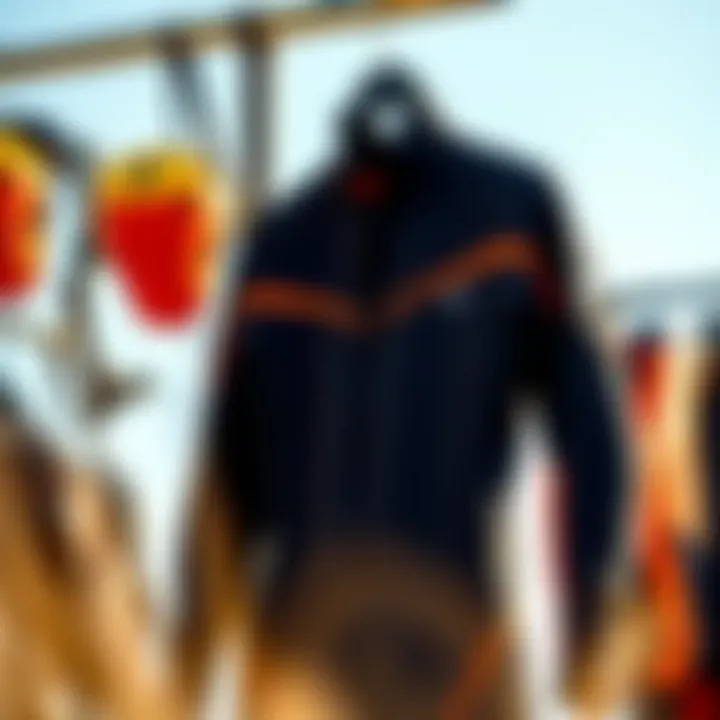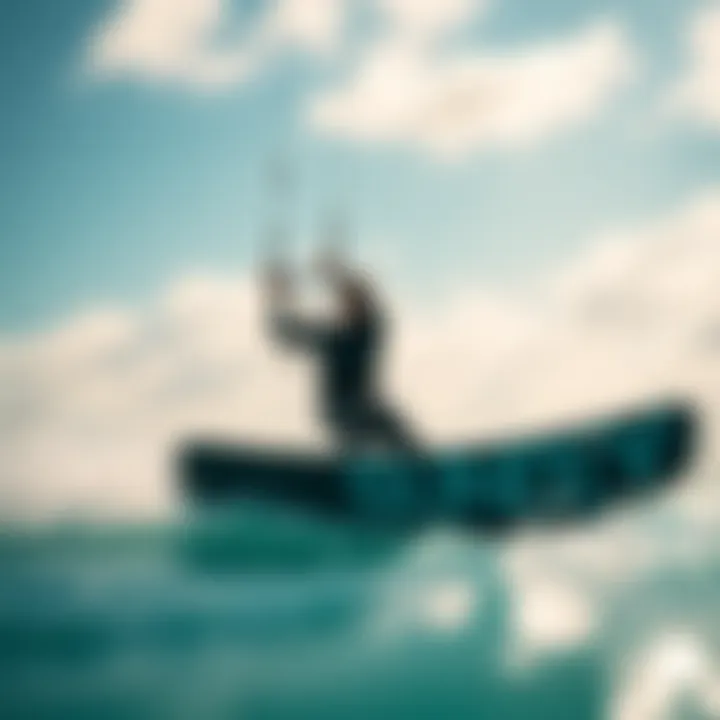Understanding Wetsuits and Drysuits for Kiteboarding


Intro
When it comes to kiteboarding, picking the right gear can make all the difference. Among the essentials in your kit, wetsuits and drysuits stand out as crucial components that can either keep you comfortable or leave you shivering in the water. Understanding their distinct features, materials, and applications is not merely an academic exercise; it’s a way to enhance your performance and enjoyment on the water.
Kiteboarding isn’t just about skill and technique; the right equipment plays a vital role too. Your decision on what suit to wear can greatly affect your buoyancy, thermal insulation, and freedom of movement. These factors can either help you harness the wind to its fullest potential or hinder your experience altogether. As you dig deeper, you'll find that the nuances between wetsuits and drysuits extend beyond simple preferences; they are aligned more with the conditions you face, such as water temperature and duration of your sessions.
In this article, we’ll navigate through the different types of suits available, clarify the terminology surrounding them, and help you make decisions based on your kiteboarding needs. From keeping warm during those chilly sessions to ensuring you’ve got enough flexibility to perform tricks, this guide aims to be your compass in understanding wetsuits and drysuits. So whether you’re a newbie looking to dip your toes into this exhilarating sport or a seasoned pro aiming to fine-tune your gear, this exploration of thermal garments is tailored for you.
Prelims to Wetsuits and Drysuits
Engaging in kiteboarding requires not only skill and the right equipment but also understanding how specific garments can significantly improve the experience. Wetsuits and drysuits, both players in the water sports arena, serve distinct purposes while ensuring safety and comfort for kiteboarders. This section dives into the essence of these suits, laying the groundwork for their vital role in optimizing your time on the water.
Overview of Water Sports Gear
Water sports gear encompasses a variety of equipment, yet none is as crucial for thermal regulation as wetsuits and drysuits. While a surfboard, a kite, and a harness might get you gliding across the waves, these suits provide the barrier between you and the unforgiving chill of the water.
Wetsuits are designed to trap a thin layer of water between the suit and the body, which warms up with your body heat. In contrast, drysuits are oriented more towards keeping water out entirely, making them invaluable in freezing conditions.
"In the realm of kiteboarding, the right suit can mean the difference between a fun day and a downright frigid experience."
Understanding your gear is pivotal. It helps kiteboarders prevent hypothermia in cooler waters and ensures a comfortable ride, enabling them to showcase their skills without the nagging distraction of cold water.
Importance of Thermal Protection
Thermal protection isn't just a luxury; it's a necessity. Kiteboarders often find themselves exposed to the elements for extended periods. Water temperature can drop significantly, even on sunny days. A good wetsuit or drysuit acts as a protective shield, minimizing heat loss to keep you comfortable as you ride waves.
Realizing how quick water can sap heat from the body is vital. Let’s face it, a chilly surface can turn an enjoyable day into a miserable one. For instance, while most kiteboarders enjoy the thrill of riding in the morning sun, the waters can still be quite cold, so having the right gear is imperative.
Different suits provide varied levels of thermal protection based on their thickness and design. As we delve deeper into this guide, kiteboarders can expect to understand how to choose the best suit for their specific needs and conditions.
Defining Wetsuits
Wetsuits are integral to the world of kiteboarding, serving as a bridge between the athlete and the aquatic environment. Understanding what a wetsuit is and how it functions can significantly enhance a kiteboarder's performance and overall enjoyment of the sport. They help maintain body temperature, provide a level of buoyancy, and protect against abrasions while navigating choppy waters. It’s this blend of functionality and comfort that makes the subject of wetsuits vital for anyone serious about kiteboarding.
Construction and Materials Used
Wetsuits are primarily constructed from neoprene, a synthetic rubber that's both flexible and insulating. The thickness of neoprene varies, typically falling between 2mm and 7mm, allowing for a range of thermal protection depending on water temperature. The outer layer of a wetsuit may include additional materials, like nylon or spandex, to increase durability and comfort.
The construction of wetsuits is generally categorized into several components:
- Zipper Systems: Commonly found in back, chest, or front zip designs, each offering different levels of water resistance and ease of entry.
- Stitching Techniques: Flatlock stitching is popular for warmer suits, while blind stitching adds a watertight barrier, ideal for colder conditions.
- Seams and Seals: Some suits may feature sealed seams to minimize water penetration.
This thoughtful construction is what sets wetsuits apart in the world of water sports. A well-constructed wetsuit can meet the demands of extreme conditions while ensuring that your ride remains enjoyable.
Types of Wetsuits: Short, Full, and Spring
The choice of wetsuit type significantly impacts performance. There are various styles catering to diverse environments and preferences:
- Short Wetsuits: Also known as shorties, these cover the torso and have short sleeves and legs. They're perfect for warmer water conditions and allow for greater freedom of movement.
- Full Wetsuits: Covering the entire body, these suits are best suited for colder waters. Their longer design provides comprehensive thermal protection, making them essential for kiteboarding in harsher climates.
- Spring Suits: A blend between short and full suits, spring suits typically feature long sleeves and short legs. They offer warmth while facilitating flexibility, making them ideal during transitional seasons or warmer waters.


Depending on your local conditions, choosing the right type can significantly impact your comfort and effectiveness while kiteboarding.
Choosing the Right Thickness
Selecting the right thickness of a wetsuit boils down to assessing various factors, including the water temperature and personal preference. As a rule of thumb, a thicker wetsuit provides greater insulation, though it may restrict movement slightly more than thinner options. Here’s a quick guideline:
- Water warmer than 75°F (24°C): 2mm to 3mm suits, shorties recommended.
- Water temperature between 65°F (18°C) to 75°F (24°C): 3mm to 4mm full wetsuits suitable.
- Water colder than 65°F (18°C): 5mm or thicker suits, typically full coverage.
When deciding on thickness, it’s essential not only to consider the water temperatures but also your own tolerance for cold. Some kiteboarders may prefer a thicker suit in even slightly cooler waters for that added warmth, while others might opt for thinner options that allow for better maneuverability.
In summary, a wetsuit defines much more than just a fabric covering the skin; it represents an essential piece of gear that can enhance your kiteboarding experience, ensuring that you feel comfortable and secure as you chase the waves. With careful consideration of construction, type, and thickness, you can select a wetsuit that complements your style and environment.
Exploring Drysuits
Drysuits have carved out a niche for themselves in the world of water sports, particularly for kiteboarders who dare to tackle the chill of colder waters. Understanding the unique aspects of drysuits is essential for anyone looking to extend their kiteboarding season beyond the summer months.
Material Composition and Design Features
Drysuits are constructed from a variety of materials, with the most common being neoprene or specialized waterproof fabrics like Gore-Tex. These materials differ in terms of flexibility, insulation, and thermal efficiency. Drysuits usually contain multiple layers: an outer shell that protects against water and abrasion, and an inner layer that provides insulation by trapping air.
One advantage of drysuits is their design features, which include waterproof zippers and adjustable neck and wrist seals. These seals are crucial for preventing water ingress, thereby keeping the user dry even in frigid conditions. Additionally, the cut of a drysuit allows for a full range of motion, ensuring that kiteboarders can maneuver comfortably.
"A well-fitted drysuit can be your best friend when the waters get cold; it’s like wearing your own warm bubble!"
Ventilation and Sealing Systems
A point of discussion among users is the ventilation system incorporated in various drysuit designs. While maintaining warm air inside is vital, so is ensuring that the suit does not become too humid during activity. Drysuits often feature ventilation systems that allow for airflow, helping to balance warmth and moisture levels. These can come in the form of zippered vents located in strategic spots, usually around the upper body.
The sealing systems employed in drysuits significantly impact performance and comfort. Effective seals around the neck and wrists are indispensable; they keep water out while permitting a snug fit that doesn’t restrict movement. Thus, many drysuit manufacturers invest time into perfecting these areas to ensure they perform well under rough conditions.
Suit Applications in Cold Water
Drysuits shine in environments where temperatures plummet. They are the preferred choice for kiteboarders braving icy waters, as they provide superior insulation compared to wetsuits. Whether you're out to catch those winter gusts or simply enjoying a coastal ride as the days cool down, a drysuit enables you to keep kiteboarding comfortably.
Kiteboarding events in colder climates invariably lead participants to rely on drysuits. The thickness and layering options available allow kiteboarders to select a suit tailored to their specific needs, offering flexibility in selecting insulation levels based on water temperatures.
For more detailed insights, you may explore resources such as Wikipedia on Drysuits or check out discussions on Reddit for real-world experiences and tips from fellow kiteboarders.
Comparison of Wetsuits and Drysuits
In the realm of kiteboarding, the decision between a wetsuit and a drysuit is more than a matter of preference—it's about ensuring your comfort, safety, and performance while riding the waves. Understanding the differences between these two types of suits can significantly affect your experience on the water. Kiteboarding often involves varying weather conditions, water temperatures, and personal comfort levels. This section addresses the critical elements that define each suit type and how they serve different needs in this exhilarating sport.
Thermal Regulation Capabilities
Wetsuits and drysuits tackle thermal regulation in unique ways. Wetsuits are designed to be snug against your skin, allowing a thin layer of water to enter. This water warms up against your body, creating a thermal barrier that helps retain heat. However, in colder water conditions, this can sometimes become a challenge, as the body continues to lose warmth after a while.
On the contrary, drysuits are engineered to keep water completely out. Made from waterproof materials and sealed at openings, they safeguard the body from frigid water exposure. Many drysuits are equipped with breathable membranes that allow moisture from your sweat to escape, keeping you dry without sacrificing warmth. For instance, when tackling chilly early spring sessions on the water, opting for a drysuit could mean the difference between a fun day and a hypothermia scare.
Buoyancy and Weight Differences


Buoyancy is another fundamental difference between these suits. Wetsuits tend to provide some level of buoyancy due to the neoprene material they are made from. This buoyancy can help keep you afloat, assisting with water entry and exit. Yet, wearing a thick wetsuit might leave you feeling bulkier and heavier in the water, especially if submerging or navigating through waves.
Drysuits, conversely, generally offer more substantial buoyancy due to their design and the inclusion of air pockets. This characteristic can be a boon in rough waters. However, it's vital to be mindful of how the buoyancy affects your kiteboarding dynamics. A drysuit can make you feel almost like a balloon if not managed correctly. Striking a balance between buoyancy and agility is key, particularly when picking up speed on those lengthy downwind rides.
Usage Scenarios in Kiteboarding
The context in which one chooses to use a wetsuit or a drysuit is crucial. Wetsuits are often ideal for moderate water temperatures. A kiteboarder might reach for a wetsuit in the summer months when water temperatures are more forgiving but still chilly enough to warrant some insulation. They're lightweight and allow for a greater range of movement, that sweet freedom while executing tricks or handling jumps.
Drysuits shine in colder climates or extended sessions when water temperatures dip below a comfortable threshold. Those aiming for winter kiteboarding adventures or venturing into colder regions will find a drysuit to be indispensable. It’s often said that if you’re planning to kite in icy waters, a drysuit is your best friend—a thought that hangs true among many seasoned riders.
Epilogue
In summary, the choice between a wetsuit and a drysuit ultimately comes down to personal needs regarding thermal protection, buoyancy, and the specific conditions you expect to encounter while kiteboarding. By taking these factors into account, riders can make informed decisions that enhance their performance and safety on the water.
Selecting the Right Suit for Your Needs
Selecting the right wetsuit or drysuit is not just a matter of preference; it is essential for your comfort and performance in kiteboarding. The suit you choose directly impacts your ability to stay warm, buoyant, and agile in the water. Understanding your specific needs allows you to enjoy your time on the water to the fullest. This section dives into key elements like water conditions, personal comfort, and budget considerations to help you make an informed choice.
Assessing Water Conditions
Before you even consider trying on suits, you must think about the conditions of the water where you’ll be kiteboarding. The temperature of both air and water plays a tremendous role in determining which suit is best for you.
- Cold Water: When the water is chilly, you're better off with a thicker wetsuit or a drysuit, since they provide more insulation. A 5/4mm wetsuit is common for colder conditions, ensuring you keep your core temperature stable.
- Warm Water: On warmer days, a thinner wetsuit or a shorty may do just fine. These options offer protection against sunburns and minor scrapes, all while keeping you cool.
- Wind Conditions: Higher winds can lead to cooler wind-chill factors, even in warmer water. This point emphasizes the need to be aware of environmental aspects before gearing up.
In essence, know the water you're diving into! Consider the local weather trends, and leverage reports to ensure you're prepared for whatever Mother Nature has in store.
Evaluating Personal Comfort Preferences
At the end of the day, even the best suit won't serve you well if you don't feel comfortable wearing it. Personal comfort comes into play in various aspects that can affect your kiteboarding performance.
- Fit: When trying on suits, ensure it fits snugly without being too tight. You shouldn’t feel constrained while moving. A well-fitted suit feels like a second skin, allowing you to perform at your best.
- Material Feel: Different suits come with various materials that affect how they feel on your skin. Some prefer the smoothness of neoprene, while others favor a more rugged texture for durability. Test different suits, and pay attention to how they feel during movement.
- Entry Systems: Consider whether a front zip, back zip, or suit without a zip is more comfortable for you. Zippers can affect your mobility, and having a good entry system can make a difference in how easily you can get in and out of your suit.
When assessing comfort, don’t hesitate to spend some time in a suit. Move around in it, simulate kiteboarding movements, and see what feels right.
Budget Considerations
Money matters. When shopping, it’s wise to set a budget that makes sense for your needs without breaking the bank.
- Quality vs. Price: Consider quality as a long-term investment. Sometimes, spending a bit more can lead to a more durable suit that lasts several seasons, saving you money in the long run.
- Sale Seasons: Look for sales at the end of the season or special promotions online. Many retailers drop prices to clear inventory, giving you a chance to snag a good deal.
- Second-Hand Options: Sometimes, you can find excellent used suits in great condition. Just make sure to check for wear and tear, especially on seams and zippers.
"Choosing the right suit isn't just about staying warm or looking good on the water; it’s about maximizing your enjoyment and performance in kiteboarding."
Thinking through these areas—water conditions, comfort, and budget—will set you on the right path to selecting a suit that suits you just right. Don't underestimate the importance of each factor; instead, treat them as critical components that contribute to your overall kiteboarding experience.
Maintenance and Care of Wetsuits and Drysuits
When it comes to enjoying kiteboarding, a well-maintained wetsuit or drysuit can make all the difference. These suits don't just serve to keep you warm; they're essential for your comfort and safety on the water. However, the harshness of saltwater, UV rays, and general wear and tear can take their toll on these garments. Proper maintenance and care ensure that your investment lasts longer, performs better, and remains comfortable. Below are key components of taking care of your suits that every kiteboarder should know.
Proper Cleaning Techniques


Cleaning your wetsuit or drysuit might seem straightforward, but there's more to it than just a rinse with cold water. Here’s a breakdown of effective cleaning methods:
- Freshwater Rinse: After each use, especially in saltwater, give your suit a good rinse in fresh water. This removes salt, sand, and other debris that could damage the material.
- Gentle Detergents: When it's time for a deeper clean, use a mild soap specifically designed for wetsuits. Harsh detergents can degrade the neoprene and lead to faster wear.
- Inside-Out Washing: Turn your suit inside out when cleaning. This helps remove sweat, oils, and bacteria, which can lead to odors and deterioration over time.
- No Machine Washing: Avoid throwing your suit in a washing machine, as the agitation and heat can damage the suit’s integrity.
Storage Recommendations
Storing your wetsuit or drysuit properly is essential for its longevity. The way you store them can determine how well they hold up for your next adventure. Here’s what to keep in mind:
- Hang Dry: After cleaning, hang your suit to dry away from direct sunlight. UV rays can break down materials over time.
- Avoid Folding: Never fold your suit for storage. Instead, hang it on a wide hanger to avoid creasing or pinching.
- Cool, Dry Place: Store your suit in a cool, dry environment. Excess heat or moisture can create problems like mold or mildew, which are not easy to get rid of.
- Use Suit Bags: If possible, use a breathable suit bag. This protects it from dust and other environmental factors, maintaining its integrity.
Common Repair Methods
Even with the best care, accidents happen. Knowing how to tackle minor repairs can save you time and money. Here are some common repair techniques that kiteboarders should familiarize themselves with:
- Neoprene Glue: For small tears or punctures, neoprene glue works wonders. It’s essential to clean the area first, apply the glue, and let it cure according to the product instructions.
- Seal Joints: If you notice any seams starting to peel or open, re-sealing them with a specialized seam tape can prolong the life of your suit significantly.
- Professional Repairs: For larger tears or significant damage, it’s best to consult a professional. Many shops offer repair services specifically for wetsuits and drysuits, ensuring your gear is as good as new.
Maintenance isn’t just about keeping your suit looking good; it’s about extending its life and ensuring both performance and comfort. By incorporating these cleaning tips, storage practices, and repair methods into your routine, you will be well on your way to nurturing your wetsuit or drysuit for many kiteboarding seasons to come.
Innovations in Wetsuit and Drysuit Technology
Innovations in wetsuit and drysuit technology play a pivotal role in improving the experiences and performance of kiteboarders in various water conditions. As technologies evolve, so do the materials and designs used in these essential suits. Understanding these advancements is crucial for enthusiasts looking to enhance their time on the water. With a combination of comfort, durability, and performance, modern suits are tailored to meet the demands of riders, offering features that help them cope with diverse environments.
Latest Material Advancements
The shift in material technology has revolutionized the way wetsuits and drysuits are manufactured. Traditionally, neoprene was the go-to material, providing adequate thermal insulation and flexibility. However, now, manufacturers are experimenting with alternative materials that elevate comfort and performance to new heights.
- Yamamoto Neoprene: Sourced from limestone, this environmentally friendly material is lighter and has better insulation properties than standard neoprene. Kiteboarders utilizing suits made from Yamamoto Neoprene often boast about increased buoyancy and warmth.
- Graphene-infused Fabrics: Graphene is hailed as a game-changer within the wetsuit sector. Its lightweight nature and incredible thermal conduction make it an excellent option for insulation. Suits with graphene can retain heat while being much thinner than conventional options.
- Eco-Friendly Alternatives: With an increased focus on sustainability, brands have invested in producing suits made from recycled materials, ensuring minimal environmental impact. These eco-friendly wetsuits not only look after the oceans but also perform admirably, proving that one can be conscious of the environment without compromising on quality.
Smart Features in Modern Suits
The incorporation of technology into wetsuits and drysuits is transforming the very foundation of aquatic gear. Today's suits come equipped with features aimed at enhancing the safety and comfort of kiteboarders:
- Built-in Temperature Regulation: Some modern suits integrate advanced thermoregulation systems that actively adjust to body temperature changes, ensuring that wearers remain comfortable throughout their time on the water. This feature is particularly beneficial during long sessions in fluctuating conditions.
- GPS Technology: The integration of GPS within the suits allows kiteboarders to track their performance. Information such as speed and distance traveled can provide valuable insights for improvement and training purposes.
- Seamless Connectivity: Advances in wireless technology enable connectivity to smartphones or action cameras right from the suit. This allows users to record their exploits without the hassle of carrying gear separately.
"As kiteboarding evolves, so does our gear. It's not just about staying warm anymore; it's about using technology to elevate performance and embrace a new adventure on the water."
Environmental Considerations and Sustainability
As we dive into the world of kiteboarding, one must not overlook the footprint left behind by our beloved sports gear. Understanding the environmental considerations and sustainability in wetsuits and drysuits is crucial—not only for kiteboarders but for the planet we choose to ride on. Selecting eco-friendly materials and engaging in sustainable practices not only protects marine ecosystems but can also influence the longevity and quality of our gear.
Eco-Friendly Materials and Production
In recent years, the industry has made significant strides towards fabricating wetsuits and drysuits with a lesser impact on the environment. Historically, traditional neoprene has been a staple for thermal protection, yet its production has spurred concerns regarding harmful emissions. Enter eco-friendly alternatives like limestone-based neoprene, derived from natural sources, significantly reducing the carbon footprint associated with suit manufacture. Brands like Patagonia and O'Neill are spearheading this movement, pushing towards materials that are not only durable but also sustainable.
Moreover, natural rubber is gaining traction. It's biodegradable and often originates from renewable resources, providing a promising alternative without compromising performance. Fabrics treated with water-based adhesives rather than solvent-based ones are another note-worthy advancement, paving a smoother path to sustainability while keeping our oceans healthier.
Impact of Gear on Marine Life
It's essential to consider how our chosen gear interacts with the vast marine environments we frequent. Over time, wetsuits and drysuits can shed microplastics, which pose significant threats to marine creatures. These tiny bits are small enough to be ingested by fish, leading to a ripple effect throughout the food chain. Thus, opting for eco-friendly materials can lead to a reduction in such pollution.
In addition to the materials, the production practices play a crucial role. Responsible manufacturing not only mitigates pollutants entering our waters, but also fosters better working conditions and local economies. Educating oneself and making mindful purchases can contribute toward a reduction in water pollution as well as supporting brands committed to environmental stewardship.
"The choices we make today shape the oceans we ride tomorrow."
Kiteboarders hold significant power in shaping the future of water sports. By prioritizing environmentally-responsible brands and gear, enthusiasts not only enjoy their passion but also contribute toward a healthier planet. Every suit purchased is a vote cast; therefore, choosing wisely can have both immediate and far-reaching effects on marine life and watersports culture. Let's be the watermen and women who ride the waves while respecting the ecosystems we intersect with.















